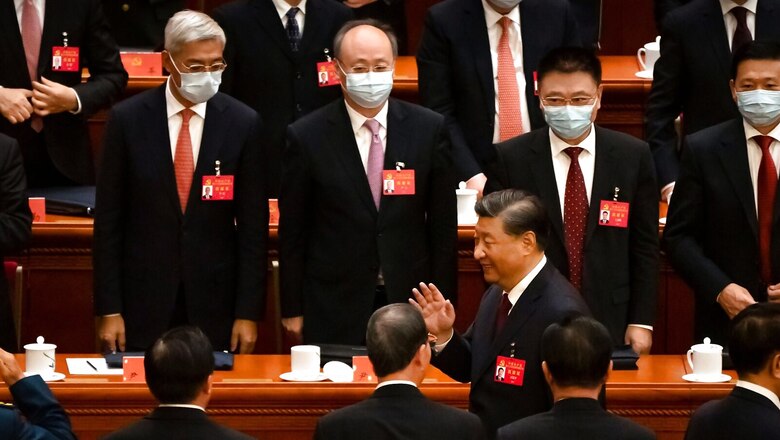
views
The 20th National Congress of the Chinese Communist Party (CCP) commenced on 16 October 2022. This highly anticipated, week-long gathering occurs every five years and is expected to cement Xi Jinping’s third term along with the likely replacement of the current premier, Li Keiqiang.
While previously obligated to serve a maximum of only 10 years (or two terms), Xi has, during the 19th Party Congress, done away with this two-term limit and is gearing up to further consolidate power and suppress any resistance. This development is expected to have major repercussions for not just China’s internal and foreign policies, but also the geopolitical landscape of the region — from Inner Asia to the Indo-Pacific.
While centralisation of power coupled with Xi’s popular slogans like ‘Common Prosperity’ is expected to be at the center of this year’s Party Congress, the various challenges facing the leader as he strives to maintain his grip on China cannot be overlooked.
What is China’s Party Congress?
Every five years, the Communist Party of China (CPC) convenes a National Party Congress. On 25 September, the party stated that 2,296 delegates from various provinces, the military, numerous ministries, divisions of government, and society had been chosen to attend this year’s event.
It typically lasts several days and involves announcements, resolutions, and, eventually, the unveiling of a small group of essential leaders within the Politburo’s 25-person membership. The three broad purposes of a Congress are to Elect New Leaders, Amend the Party Constitution, and Establish the Main Policy Direction. Delegates vote on different motions, including modifications to the CPC constitution and elect a new Central Committee, which is meant to, further, nominate a new Politburo and Politburo Standing Committee (PBSC).
With Xi Jinping ready to begin his third term, the 20th Party Congress breaks a 30-year tradition of limiting presidential terms to a maximum of ten years. Analysts all over the world are confused about how future leadership successions will take place. Aside from reshuffling party members, the Party Conference will also modify the party constitution and set the broad policy directions for the next five years, which Xi will detail in a speech to the congress.
China’s Mounting Challenges
The first and foremost challenge pertains to CCP’s “Dynamic Zero-Covid” Policy. Introduced as an attempt to prevent any community spread of the coronavirus, this stringent policy has had far-reaching effects for not just the Chinese economy, but also its population. Chinese citizens have been unable to obtain food and medicine due to the announcement of harsh blanket lockdowns in entire localities and even cities. It has increased unemployment in the country and has prompted global customers to seek alternate export destinations as concerns about disruptions to China’s supply chains mount. It has imposed heavy financial costs on local governments, which were already highly indebted and revenue starved.
Mainland China is one of only three regions still following a Zero-Covid Policy as of October 2022. China’s economy is largely driven by exports and the prolonged isolation of the $18-trillion economy from the global supply chain might wreak havoc for its already ailing economy. Thus, analysts are looking for evidence that hints towards a possible relaxation of the Zero-Covid Policy following the 20th Party Congress.
This takes us to the next challenge, which is mainly ascribed to being an extension of the first, the Economic Crisis in China. The primary domestic challenge confronting Xi is China’s economic decline, which has been intensified by long-drawn-out lockdowns as a result of the CCP’s Covid Policy. The World Bank predicts that China’s GDP growth in 2022 will be 2.8 percent, much below the CCP’s objective of 5.5 percent. This aggravated the domestic economic crisis China was already facing due to the protracted real estate and financial crises, with double-digit fall in transactions, and bankrupt real-estate companies, as well as halted productivity growth and rising income disparity in the country. Analysts feel that tackling this dilemma is critical for the CCP as it challenges the party’s fundamental claim to legitimacy and diminishes China’s economic clout, which has been used to project influence overseas. It is worth noting that economic development has slowed under Xi’s leadership compared to previous presidents Jiang Zemin and Hu Jintao.
In addition, China faces a significant obstacle in the form of the Taiwan ambiguity, which is expected to become increasingly important in the years to come. There is growing uncertainty among international investors and overseas companies on whether or not China would undertake some form of military action in the years to come against Taiwan. This has been aggravated due to Russia’s invasion of Ukraine and the subsequent sanctions imposed on Russia by the world’s major democracies. Due to this, global firms are already facing billions of dollars in losses. Needless to say, investors and multinational corporations are treading cautiously at the time. Even a passing comment that hints at the possibility of “reunification” between Taiwan and the mainland can be detrimental to investors’ trust in both Taiwan and the mainland.
China’s foreign policy and diplomatic outreach Initiatives appear to be struggling as well. China’s increasingly negative global image is the result of various strategies implemented by the government. China’s aggressive diplomacy (popularly known as the Wolf warrior diplomacy); deteriorating ties with the United States, Japan, and India; growing fear of economic coercion on debt-ridden nations; and an aggressive approach to geopolitically sensitive areas such as Xinjiang, Hong Kong, and Taiwan have all done significant damage to Beijing’s public image. According to a recent Pew Research Center survey, China’s public image remained largely negative in many nations. Additionally, in recent years we have seen a global trend toward the closure of Confucius Institutes.
China’s foreign policy initiatives have also lessened the appeal of economic cooperation with China for Western markets and enterprises. According to Jorg Wuttke, President of the EU Chamber of Commerce in China, European corporations are losing interest in continuing to invest in China and are instead exploring elsewhere in Asia. Beijing’s support for Russia throughout the Ukraine crisis has intensified the desire for decoupling.
To lessen reliance on sole-source suppliers in China and lower the chance of falling victim to regulatory disputes, sanctions, export bans, and other financial and commercial restrictions, supply chains are being reorganized or reconfigured. The Supply Chain Resilience Initiative, a trilateral agreement between India, Japan, and Australia to improve supply chain resilience, is one noteworthy example.
Conclusion
On the policy front, it is projected that there would be more continuity than change. This year’s Party Congress is expected to be driven by Xi’s campaigns, which include Common Prosperity to reduce inequality, Dual Circulation to tap into China’s domestic market, and Self-Reliance in key strategic sectors. The struggling Chinese economy, however, is a huge hurdle to accomplishing these goals, and the blame is mostly placed on the rigorous “Zero-Covid” Policy. Analysts, investors, and the world’s political elite will be watching the 20th Party Congress with bated breath, seeking to decipher the future of China’s Covid policy, the viability of investment in the nation, and the likelihoods of an economic resuscitation in the near future.
The 20th Party Congress is unquestionably significant, as the Party is expected to lay down its roadmap for the upcoming years, which are considered critical for China’s pursuit in attaining both national rejuvenation and modernisation aspirations.
Esha Banerji specialises in Defence and Strategic Studies at the Savitribai Phule Pune University. The views expressed in this article are those of the author and do not represent the stand of this publication.
Read all the Latest Opinion News and Breaking News here


















Comments
0 comment